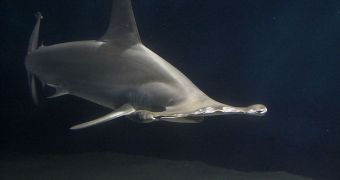The hammerhead shark is arguably one of the most peculiar animals in the world, especially in terms of how it looks. It eyes are located far away from each other, giving it a face to laugh at. Researchers have been fascinated with the chain of evolutionary changes that led to this fish developing in the manner it did, and so recently they decided to conduct a new study on its ancestry. Scientists learned that the ancestor from which this creature – and its modern-day relatives – emerged appeared more than 20 million years ago, LiveScience reports. With time, the lineage diversified to the point we can see today.
“Our study indicates the big hammerheads probably evolved into smaller hammerheads, and that smaller hammerheads evolved independently twice,” explains University of Colorado in Boulder (UCB) evolutionary biologist Andrew Martin, who was also a member of the team that conducted the new study. Hammerheads feature flattened heads, which are elongated on the sides. At the extremities, they carry their eyes, which are spread further apart than in any other known fish species. The animals, which can grow in size between 1 and 5.5 meters (5 to 18 feet), are among the most recognizable creatures on the face of the planet.
The investigation revealed that two main reasons may exist for why the large hammerhead shark species of the past evolved into the smaller ones we say today. The paper shows that one possible explanation is a phenomenon known as neoteny. It happens when animals develop the ability to retain some of the traits they had as juveniles well into adulthood. When it comes to humans, we look like scaled-down versions of ourselves when we are born. But creatures of other species sometimes look very different when they are born from when they are adult.
The second cause for this type of evolution may have been an adaptation the sharks underwent, so that they could better occupy their environment. Researchers believe that, at one point, the creatures may have begun mating at earlier ages than usual. “As the sharks became smaller, they may have begun investing more energy into reproductive activities instead of growth,” Martin reveals. Additional details of the work appear in the May issue of the esteemed scientific journal Molecular Phylogenetics and Evolution.

 14 DAY TRIAL //
14 DAY TRIAL //